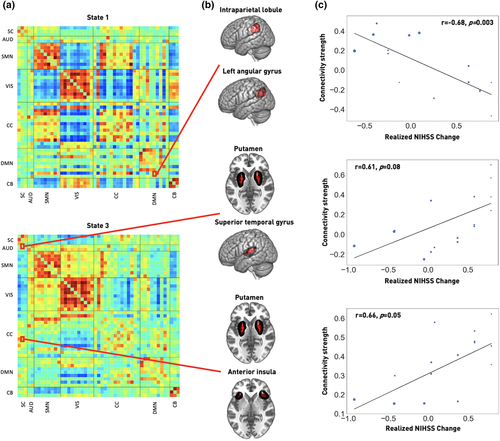Abnormal dynamic functional connectivity is linked to recovery after acute ischemic stroke
The aim of the current study was to explore the whole‐brain dynamic functional connectivity patterns in acute ischemic stroke (AIS) patients and their relation to short and long‐term stroke severity.
We investigated resting‐state functional MRI‐based dynamic functional connectivity of 41 AIS patients two to five days after symptom onset. Re‐occurring dynamic connectivity configurations were obtained using a sliding window approach and k‐means clustering. We evaluated differences in dynamic patterns between three NIHSS‐stroke severity defined groups (mildly, moderately, and severely affected patients). Furthermore, we built Bayesian hierarchical models to evaluate the predictive capacity of dynamic connectivity and examine the interrelation with clinical measures, such as white matter hyperintensity lesions. Finally, we established correlation analyses between dynamic connectivity and AIS severity as well as 90‐day neurological recovery (ΔNIHSS).
We identified three distinct dynamic connectivity configurations acutely post‐stroke. More severely affected patients spent significantly more time in a configuration that was characterized by particularly strong connectivity and isolated processing of functional brain domains (three‐level ANOVA: p < .05, post hoc t tests: p < .05, FDR‐corrected; Fig. 1).

Configuration‐specific time estimates possessed predictive capacity of stroke severity in addition to the one of clinical measures. Recovery, as indexed by the realized change of the NIHSS over time, was significantly linked to the dynamic connectivity between bilateral intraparietal lobule and left angular gyrus (Pearson's r = −.68, p = .003, FDR‐corrected).
Our findings demonstrate transiently increased isolated information processing in multiple functional domains in case of severe AIS. Dynamic connectivity involving default mode network components significantly correlated with recovery in the first 3 months poststroke (Fig. 2).

Publication:
Bonkhoff, A. K., Schirmer, M. D., Bretzner, M., Etherton, M., Donahue, K., Tuozzo, C., Nardin, M., Giese, A.-K., Wu, O., Calhoun, V. D., Grefkes, C., & Rost, N. S. (2021). Abnormal dynamic functional connectivity is linked to recovery after acute ischemic stroke. Human Brain Mapping.
